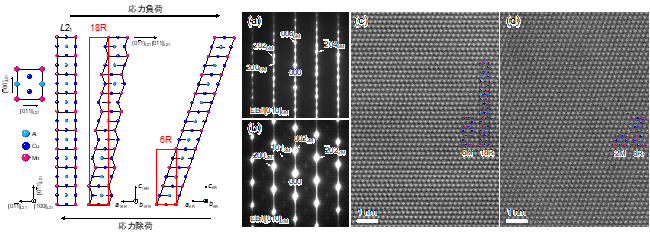2025-05-16 長崎大学

図1 透過電子顕微鏡による結晶構造変化の観察結果
(a, b) 6M(18R)構造および2M(6R)構造から取得した電子回折図形
(c, d) 6M(18R)構造および2M(6R)構造の原子分解能像
<関連情報>
- https://www.nagasaki-u.ac.jp/ja/science/science389.html
- https://www.sciencedirect.com/science/article/pii/S1359645425003441?via%3Dihub
単結晶Cu-Al-Mn形状記憶合金における大きな応力-ひずみヒステリシスを伴う連続的な応力誘起相転移 Successive stress-induced phase transformations with large stress-strain hysteresis in single crystal Cu-Al-Mn shape memory alloys
Hiroshi Akamine, Ryo Takamatsu, Sheng Xu, Toshihiro Omori, Ryosuke Kainuma, Sumio Kise, Kakeru Ninomiya, Maiko Nishibori, Minoru Nishida
Acta Materialia Available online: 15 April 2025
DOI:https://doi.org/10.1016/j.actamat.2025.121054
Abstract
The successive stress-induced phase transformations in single-crystal Cu-Al-Mn alloys, which exhibit excellent superelasticity and ductility, were investigated using electron microscopy and synchrotron X-ray diffraction. In a Cu-16.8Al-9.6Mn (at.%) alloy, which is in the martensitic phase at room temperature, a stress-induced martensitic transformation from a 6M-type stacking structure to a 2M-type stacking structure was revealed. At the 6M and 2M interface, it was observed that structural changes progress with partial dislocations running every three layers within the 6M structure. A Cu-17Al-11Mn (at.%) alloy, which is in the parent L21 phase at room temperature and exhibits superelasticity, undergoes a successive stress-induced phase transformation of L21 → 6M → 2M, resulting in a shape recovery exceeding 16 % in strain. The 6M → 2M transformation leads to an expansion of the stress-strain hysteresis loop, thereby enhancing the energy dissipation capability. The microstructure observations suggest that deformation in the 2M phase and the complex form of the reverse transformation contribute to the energy dissipation.



